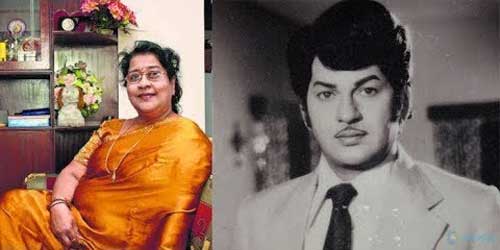ETV Bharat / sitara
ఎన్టీఆర్ పక్కన సీతగా.. ఎంజీఆర్ సోదరిగా - geetanjali
సీనియర్ నటి గీతాంజలి.. బుధవారం రాత్రి తుదిశ్వాస విడిచారు. అంతకు ముందు జరిగిన కొన్ని ఇంటర్వ్యూల్లో తన జీవితం, సినిమాలకు సంబంధించిన పలు విషయాల్ని పంచుకున్నారు.

సీనియర్ నటి గీతాంజలి
By
Published : Oct 31, 2019, 11:20 AM IST
| Updated : Oct 31, 2019, 2:23 PM IST
సీనియర్ నటి గీతాంజలి.. తెలుగు చిత్రసీమలో తనదైన ముద్రవేశారు. అలనాటి అగ్రహీరో ఎన్టీఆర్ పక్కన సీత పాత్ర పోషించే అవకాశం దక్కించుకున్నారు. పెళ్లయిన తర్వాత సినిమాలకు దూరమయ్యారు. ఆ తర్వాత అడపాదడపా సహాయ పాత్రల్లో కనిపించారు. బుధవారం రాత్రి హైదరాబాద్లో గుండెపోటుతో మరణించారు. అంతకు ముందు జరిగిన ఓ ఇంటర్వ్యూలో తన సినీ ప్రయాణం, జీవితానికి సంబంధించిన పలు ఆసక్తికర విషయాలు చెప్పారు.
అసలు పేరు 'గీతాంజలి' కాదు
గీతాంజలి అసలు పేరు మణి. 1963లో 'పారస్మణి' అనే హిందీ సినిమాలో నటిస్తుండగా ఆ చిత్ర నిర్మాతలు లక్ష్మీకాంత్-ప్యారేలాల్.. టైటిల్లో మణి ఉంది కాబట్టి ఈమెకు గీతాంజలి అని పేరు సూచించారు.
అలా ఎన్టీఆర్ పక్కన సీతగా..
సీతారామ కల్యాణం సినిమాలో సీతగా గీతాంజలి "నన్ను ఇప్పటికీ చాలామంది ఎన్టీఆర్ సీత అనే పిలుస్తారు. ఆ గొప్పదనమంతా పెద్దాయనదే. హీరోయిన్గా తొలి సినిమా అది. నా మొదటి చిత్రం 'రాణీ రత్నప్రభ'లోని ఓ డ్యాన్స్ బిట్లో చూసిన రామారావుగారు.. 'అమ్మాయి బాగుంది. సీత పాత్రకు నప్పుతుంది' అని దర్శకుడు సుబ్బారావుకు చెప్పారు. అలా 'సీతారామ కల్యాణం'లో హీరోయిన్ అయిపోయా" -గీతాంజలి, సీనియర్ నటి
ఎంజీఆర్ చెల్లెలు పాత్రంటే గీతాంజలినే
"ఎంజీఆర్ చెల్లెలుగా చాలా సినిమాల్లో చేశాను. చెల్లెలు పాత్ర అనగానే 'గీతాంజలిని తీసుకోండి' అనేవారాయన. చాలా మంచి మనిషి. ఏదైనా సినిమా ఒప్పుకోకపోతే ‘నువ్వు నా చెల్లెలివేనా, నా పక్కన నటించవా’ అనేవారు" -గీతాంజలి, సీనియర్ నటి
నటి గీతాంజలి-ఆమె భర్త రామకృష్ణ పెళ్లి తర్వాతే వంట నేర్చుకున్నా..
"నేనూ, రామకృష్ణగారు కలిసి చాలా సినిమాల్లో పనిచేశాం. 'పెళ్లిరోజు' సినిమా అప్పుడు మా పెళ్లి ప్రస్తావన వచ్చింది. మాది లవ్ మ్యారేజ్ కాదు. నాన్న కుదిర్చిన పెళ్లి. పెళ్లయ్యాక నా భర్త.. 'విశ్రాంతి తీసుకో' అనడం వల్ల గృహిణిగా సెటిలైపోయా. పెళ్లి తర్వాతే వంట నేర్చుకున్నా" -గీతాంజలి, సీనియర్ నటి
ఎన్టీఆర్ను తన సినీ గురువుగా గీతాంజలి చెప్పుకునేవారు. సీత పాత్ర వల్లే తెలుగులో తనకు ప్రత్యేక గుర్తింపు వచ్చిందని ప్రతి ఇంటర్వ్యూలోనూ ఈమె వెల్లడించేవారు. గీతాంజలి చివరి చిత్రం తమన్నా కథానాయికగా రూపొందుతున్న 'దటీజ్ మహాలక్ష్మి'.
ఇది చదవండి: సీనియర్ నటి గీతాంజలి కన్నుమూత
సీనియర్ నటి గీతాంజలి.. తెలుగు చిత్రసీమలో తనదైన ముద్రవేశారు. అలనాటి అగ్రహీరో ఎన్టీఆర్ పక్కన సీత పాత్ర పోషించే అవకాశం దక్కించుకున్నారు. పెళ్లయిన తర్వాత సినిమాలకు దూరమయ్యారు. ఆ తర్వాత అడపాదడపా సహాయ పాత్రల్లో కనిపించారు. బుధవారం రాత్రి హైదరాబాద్లో గుండెపోటుతో మరణించారు. అంతకు ముందు జరిగిన ఓ ఇంటర్వ్యూలో తన సినీ ప్రయాణం, జీవితానికి సంబంధించిన పలు ఆసక్తికర విషయాలు చెప్పారు.
అసలు పేరు 'గీతాంజలి' కాదు
గీతాంజలి అసలు పేరు మణి. 1963లో 'పారస్మణి' అనే హిందీ సినిమాలో నటిస్తుండగా ఆ చిత్ర నిర్మాతలు లక్ష్మీకాంత్-ప్యారేలాల్.. టైటిల్లో మణి ఉంది కాబట్టి ఈమెకు గీతాంజలి అని పేరు సూచించారు.
అలా ఎన్టీఆర్ పక్కన సీతగా..
సీతారామ కల్యాణం సినిమాలో సీతగా గీతాంజలి "నన్ను ఇప్పటికీ చాలామంది ఎన్టీఆర్ సీత అనే పిలుస్తారు. ఆ గొప్పదనమంతా పెద్దాయనదే. హీరోయిన్గా తొలి సినిమా అది. నా మొదటి చిత్రం 'రాణీ రత్నప్రభ'లోని ఓ డ్యాన్స్ బిట్లో చూసిన రామారావుగారు.. 'అమ్మాయి బాగుంది. సీత పాత్రకు నప్పుతుంది' అని దర్శకుడు సుబ్బారావుకు చెప్పారు. అలా 'సీతారామ కల్యాణం'లో హీరోయిన్ అయిపోయా" -గీతాంజలి, సీనియర్ నటి
ఎంజీఆర్ చెల్లెలు పాత్రంటే గీతాంజలినే
"ఎంజీఆర్ చెల్లెలుగా చాలా సినిమాల్లో చేశాను. చెల్లెలు పాత్ర అనగానే 'గీతాంజలిని తీసుకోండి' అనేవారాయన. చాలా మంచి మనిషి. ఏదైనా సినిమా ఒప్పుకోకపోతే ‘నువ్వు నా చెల్లెలివేనా, నా పక్కన నటించవా’ అనేవారు" -గీతాంజలి, సీనియర్ నటి
నటి గీతాంజలి-ఆమె భర్త రామకృష్ణ పెళ్లి తర్వాతే వంట నేర్చుకున్నా..
"నేనూ, రామకృష్ణగారు కలిసి చాలా సినిమాల్లో పనిచేశాం. 'పెళ్లిరోజు' సినిమా అప్పుడు మా పెళ్లి ప్రస్తావన వచ్చింది. మాది లవ్ మ్యారేజ్ కాదు. నాన్న కుదిర్చిన పెళ్లి. పెళ్లయ్యాక నా భర్త.. 'విశ్రాంతి తీసుకో' అనడం వల్ల గృహిణిగా సెటిలైపోయా. పెళ్లి తర్వాతే వంట నేర్చుకున్నా" -గీతాంజలి, సీనియర్ నటి
ఎన్టీఆర్ను తన సినీ గురువుగా గీతాంజలి చెప్పుకునేవారు. సీత పాత్ర వల్లే తెలుగులో తనకు ప్రత్యేక గుర్తింపు వచ్చిందని ప్రతి ఇంటర్వ్యూలోనూ ఈమె వెల్లడించేవారు. గీతాంజలి చివరి చిత్రం తమన్నా కథానాయికగా రూపొందుతున్న 'దటీజ్ మహాలక్ష్మి'.
ఇది చదవండి: సీనియర్ నటి గీతాంజలి కన్నుమూత
RESTRICTION SUMMARY: NO ACCESS IRAN/NO ACCESS BBC PERSIAN/NO ACCESS VOA PERSIAN/NO ACCESS MANOTO TV/NO ACCESS IRAN INTERNATIONAL
SHOTLIST:
ASSOCIATED PRESS - NO ACCESS IRAN/NO ACCESS BBC PERSIAN/NO ACCESS VOA PERSIAN/NO ACCESS MANOTO TV/NO ACCESS IRAN INTERNATIONAL
++The Associated Press is adhering to Iranian law that stipulates all media are banned from providing BBC Persian, VOA Persian, Manoto TV and Iran International any coverage from Iran, and under this law if any media violate this ban the Iranian authorities can immediately shut down that organisation in Tehran.++
Tehran - 26 September 2019
++NIGHT SHOTS++
1. Exterior of former US embassy in Tehran
2. Great Seal of the United States sign on exterior of building
3. Tilt-down to slogans written on wall (Farsi): “This den of espionage must be shut down” and (Farsi): “Salute to Khomeini!” and (English): “There is no time for intervention in Iran any more.”
4. Pan to left from CIA poster reading (English): “More than meets the eye” to graffiti and late Iranian leader Ayatollah Ruhollah Khomeini
5. Pan to left of room containing paper shredders and communication equipment
6. Picture of hostages on wall
7. Pan from old pictures on wall to desk
8. Wide of room
9. Pan to right from phones to documents and typewriter on desk
10. Camera entering room from corridor
11. Painting showing Sgt. Ladell Maples (left) and Cpl. Steve Kirtley (right) who were taken hostage after embassy takeover
ASSOCIATED PRESS - AP CLIENTS ONLY
Tehran - 20 October 2019
12. 27-year-old Tehran resident Mitra Ahmadi passing by former US embassy
13. SOUNDBITE (Farsi) Mitra Ahmadi, 27, Tehran resident:
“I think an alternative solution could have been found. Instead of arresting and taking them (US embassy staffers) hostage - of course I don’t know if I can say they were taken hostage, I’m not sure - but anyway instead of capturing and arresting them they (the students) could have done something else, they could have sat down and talked, and asked them if they really wanted to dominate us or if it was just our impression.”
14. Tracking shot of women passing by embassy building
15. Tehran resident Mohammad Behnampoor talking to reporter
16. SOUNDBITE (Farsi) Mohammad Behnampoor, 22, Tehran resident:
“Through empty threats they are scaring many Iranians. They say we will do this, do that, we will attack. Maybe some people are scared, but I don’t fear them. Even if there is war I’ll be the first one who goes to fight America.”
17. Various of Behnampoor passing by embassy wall
ASSOCIATED PRESS - AP CLIENTS ONLY
Tehran - 26 September 2019
18. Tilt-down on containers damaged when students tried to access classified documents
19. Close of sign reading “Counter Espionage and Intelligence file being cut to find documents file (after take over)”
20. Pan to right of equipment
21. Tilt-up of communication equipment
22. Tracking shot of embassy interior
23. Corridor
ASSOCIATED PRESS - AP CLIENTS ONLY
Tehran - 20 October 2019
24. Young men and women walking
25. Close of 23-year-old Tehran resident Farzaneh Jamalzadeh's hands
26. Farzaneh Jamalzadeh talking
27. SOUNDBITE (Farsi) Farzaneh Jamalzadeh, 23, Tehran resident:
“(Cutting ties with America) has definitely affected our lives, there are sanctions, the nuclear deal issue and there are problems that the youth are suffering, because the ties are not good. The relations between the two countries are bad, and its negative impacts exist in my life as a young person. It’s footsteps are there, I can’t say it has no impact. It does.”
28. Pan to left from photographer to Tehran resident Ali Abdi
29. SOUNDBITE (Farsi) Ali Abdi, 53, Tehran resident:
“I respect my country’s officials, but personally I think that it’s almost meaningless to take over places like embassies that cannot defend themselves. It produces nothing but problems for the country. I did not support this move at that time, not just taking over this embassy, but any embassy. If we have problems, we can sit down and solve our problems. There was no need for a takeover and so on.”
ASSOCIATED PRESS - AP CLIENTS ONLY
Tehran - 26 September 2019
30. Tilt down on interior embassy wall
31. Poster on wall reading (English) “Death to USA, (Mike) Pompeo, (Donald) Trump, (John) Bolton”
32. Close of typewriter
33. Close of document about Bahraini ruler Shaykh Isa bin Salman Al Khalifa recovered after embassy takeover
34. Typewriters and documents
35. Wide of room
STORYLINE:
The US Embassy in Tehran remains frozen in 1979 as the 40th anniversary of the Iran hostage crisis approaches, a time capsule of revolutionary graffiti, Underwood typewriters and rotary telephones.
The diplomatic compound was overrun by students angered when Washington allowed ousted Shah Mohammad Reza Pahlavi into the US for medical treatment. #
What initially began as a sit-in devolved into 444 days of captivity for 52 Americans seized in the embassy.
Today, the embassy remains held by the Basij, a volunteer wing of Iran’s paramilitary Revolutionary Guard, partly as a museum and a space for student groups.
Likewise, the Iranian Embassy in Washington remains empty since then-President Jimmy Carter expelled all of Iran’s diplomats during the crisis, although it is closed to the public and maintained by the US State Department.
The 27-acre US compound sits on the corner of Taleghani Street and Mofatteh Avenue, a busy thoroughfare through downtown Tehran.
Before the 1979 Islamic Revolution, Taleghani Street was known as Takhteh-Jamshid Street, the Farsi term for Persepolis, the ancient Persian religious capital.
Mofatteh Avenue had been named after US President Franklin D. Roosevelt, whose distant cousin Kermit Roosevelt, a CIA operative, played a role in the 1953 coup that toppled Prime Minister Mohammad Mossadegh and cemented the shah’s power.
The brick gate around the compound has become famous for its anti-American murals.
On the day of the takeover, Nov. 4, 1979, Islamic students scaled its fence the same way their Marxist rivals had done earlier that year on Feb. 14.
The earlier incident was broken up by security forces, and an uneasy calm had returned to the embassy, although officials cut its staff to about 70 people.
The Great Seal of the United States on the outside wall has been defaced, although another one still is undamaged in white above the entryway of the compound’s chancery.
The two-story office block resembles a US high school, something the diplomatic staff joked about by calling it “Henderson High,” after former US Ambassador Loy Henderson.
Entering the chancery is like stepping back in time.
Rooms on the ground floors were shut and locked when Associated Press journalists visited on a recent night.
The rooms are used by student groups and others.
Up a staircase, a guide led the AP journalists through the heavy safe door that guarded the embassy’s secure vault room.
This area has become part of the Basij museum.
Inside the vault sits the embassy’s communications gear.
Those Americans who hid in the room during the takeover rendered the equipment inoperable, removing and destroying individual components of the telexes - teletype machines that could transmit messages over phone lines to the rest of the world.
By destroying only the components, the staff could easily put the machines back into use had Iranian security forces rescued the employees, as they had in the Feb. 14 incident.
“The list was prioritized, so that the last items to go were the secure teletypes that kept them connected to Washington,” journalist Mark Bowden wrote in his 2006 book, “Guests of the Ayatollah,” recounting the crisis.
“When it was decided to begin destroying them, selected parts were culled from the various bits and either smashed with a hammer or cut in half with a saw.”
That obviously didn’t happen, and the machines instead became curiosity pieces in the Basij museum.
A small placard on part of the equipment simply identifies it as a “coding and electronic communication centre.”
Against a wall near a window air conditioner sits a blue-gray metal contraption that looks like a small wood chipper.
A hose runs from it to a vacuum-cleaner-like device sitting over a large barrel.
This was the embassy’s disintegrator, an industrial-style device designed to first shred documents and materials, then burn them to ash inside the barrel.
“It was slow to work and temperamental in nature, subject to jamming at the least provocation,” recounted William J. Daugherty, a CIA officer who was among the hostages.
“Within a few minutes, the device went ‘ka-chonk’ and shut down. Using a small commercial paper shredder, we continued to destroy what we could.”
But they left behind a huge pile of shredded strips that the students later would spend weeks piecing together like a vast jigsaw puzzle of memos and reports.
Other papers didn’t get shredded.
On one table sits a CIA report on Sheikh Isa bin Salman Al Khalifa, then the ruler of the Mideast island nation of Bahrain.
Empty safes stand open, with one bearing signs of being pried apart.
Other rooms contain black-and-white photos of the embassy takeover.
A large painting of one of the images shows US Marine Sgt. Ladell Maples of Earle, Arkansas, and Cpl. Steve Kirtley of Little Rock, Arkansas, with their hands above their heads at the time of the takeover.
Images like those of surrendering American troops carry a strong resonance for hard-liners in Iran.
Hanging on another wall is an artist’s rendering of Iran’s 2016 capture of 10 US sailors in the Persian Gulf before their release a day later.
Some of the walls in the chancery bore fresh paint, although others still show some of the students’ graffiti.
“The den of espionage must be shut down,” it reads in Farsi, while another line honours Ayatollah Ruhollah Khomeini, who became supreme leader of Iran after returning from exile in France earlier in 1979.
In English, it reads: “There is no time for intervention in Iran anymore.”
One wall features a poster in Farsi reading, “Death to America,” although it offers an alternative English translation of “Down with America.”
Another reads: “Death to the USA,” with the letter “U” bearing the profile of US Secretary of State Mike Pompeo; the “S” the pompadour of President Donald Trump; and the “A” the moustache of former US national security adviser John Bolton, a long-time hawk on Iran.
“Death to America means ‘Death to Trump, John Bolton and Pompeo,’” the sign’s caption reads, quoting a February speech by Ayatollah Ali Khamenei, the current supreme leader, published by his website.
“Death to these individuals means death to American leaders. We have nothing to do with the American people,” it says
In the same speech, Khamenei added: “As long as the US government and regime continues the same malevolence, interference, evil and malice in its actions, this ‘Death to America’ will continue to be heard from the people of Iran.”
===========================================================
Clients are reminded:
(i) to check the terms of their licence agreements for use of content outside news programming and that further advice and assistance can be obtained from the AP Archive on: Tel +44 (0) 20 7482 7482 Email: info@aparchive.com
(ii) they should check with the applicable collecting society in their Territory regarding the clearance of any sound recording or performance included within the AP Television News service
(iii) they have editorial responsibility for the use of all and any content included within the AP Television News service and for libel, privacy, compliance and third party rights applicable to their Territory.
Last Updated : Oct 31, 2019, 2:23 PM IST





